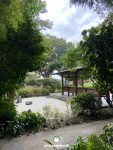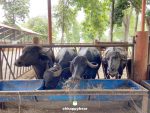For most visitors to Krungthep Maha Nakorn, the Golden Mount in the Old Town is a must-visit. But then, how many of you know that the iconic manmade mountain is a part of the ancient temple called “Wat Saket?”
The temple of Wat Saket is even older than the Golden Mountain itself. Built back in the Ayutthaya Period, this temple is ‘under the radar’ because when most people come here, they all make their way to the top of the Golden Mountain and just skip the temple area. But the story of this temple used to be a staple in the lore of Rattanakosin. And somehow, given the situation that we are all in today, that lore resonates loud and clear.
“This is why this area is also called “Pratu Phi,” or “the Ghost’s Gate.” Wat Saket was the closest temple to that gate, hence the main area for dead bodies to be cremated.”
Back in the early Rattanakosin Era, during the reign of King Rama II (1809–1824), massive cholera epidemics killed tens of thousands of people in Bangkok. Bodies were transported through the only city gate that allowed dead bodies to pass. And that city gate happened to be close to Wat Saket. This is why this area is also called “Pratu Phi,” or “the Ghost’s Gate.” Wat Saket was the closest temple to that gate, hence the main area for dead bodies to be cremated.
But then, the number of bodies outnumbered the temple’s capacity. And vultures literally swooped in and saved the day. There were so many of them roaming the temple at the time that they became a dreadful fixture. We came to know it as ‘Raeng Wat Saket’ or the Vultures of Wat Saket. And there are still vulture sculptures at the temple today as proof.
Wat Saket, as ancient as it is, is a much-revered temple. The story has it that this was where King Rama I stopped and took a bath on his way back from a war. At the front entrance to the temple, via the Chakkraphatdi Phong Road, there’s a 200-year-old bodhi tree that was planted in the era of King Rama II—a symbol of enlightenment for Buddhists everywhere.
Their main Ubosoth is also very serene and beautiful. Take your time looking at their murals. One of the best in town.
Also, just behind the main Ubosoth is the Hall of Phra Attharos, a huge cast-iron Buddha image from the Sukhothai Era.
The Golden Mount is one of our favourite spots in town. The sermons here are all about achieving inner peace and happiness, although one can absolutely seek fame and success, but still with awareness and preservation.
You do not need to take off your shoes when entering the top floor of the Golden Mount. At the beginning of our video, there was a recording telling visitors just so. Otherwise, you might lose them.
The Golden Mount took not one, not two, but three eras of our kings to complete. Initiated during King Rama III’s reign by the King himself, to be a replica of the sacred Wat Phu Khao Thong (or the Golden Mountain Temple) of Ayutthaya, the tall structure of the place proved to be a big challenge for the area’s swampy soil. The structure collapsed and was rebuilt, and redesigned. And it was finally completed in the reign of King Rama V, in the year 1877, with the enshrinement of the sacred Buddha relics at the very top of its gleaming chedi.
Well, I hope you have a great time visiting Bangkok and that you know a bit more about our history and places. Thank you for stopping by!
More of Our Bangkok Food & Places Guides
Thailand’s Food Culture. What is Thai Food? Is It always spicy?
26 Best Thai Dishes to Eat in Bangkok, Thailand
5 Best Fishball Noodles in Bangkok
Top 10 Things to Buy in Bangkok (Shopping Guide)
5 Favourite Non-Mall, Old-School Bangkok Restaurants
5 Best Cheap Thai Restaurants in Bangkok
17 Places to Eat in Bangkok’s Chinatown (Yaowarat)
10 Places to Eat in Bangkok Old Town (Rattanakosin Island)
16 Places to Shop in Bangkok – A Bangkok Shopping Guide
8 Things to do in Bangkok Old Town (Rattanakosin Island)
Bangkok Top 10 Attractions
How to Get Around in Bangkok
Bangkok Long Weekend – An Essential Guide
Bangkok – A Foodie Paradise

